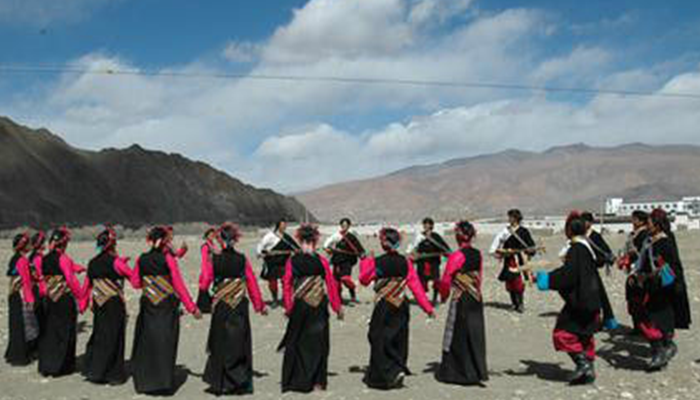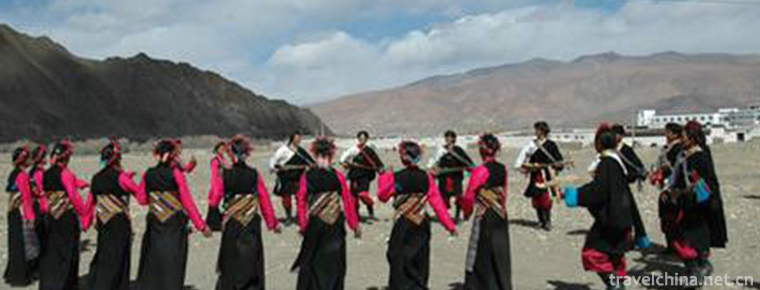Heap harmonics
Heap harmonics
"Heap Harmony" first spread in the Yarlung Zangbo River Basin, the high terrain west of Shigaze to the whole area of Ali circle dance, and later gradually prevailed in Lhasa. It was the first dance accompanied by six stringed instruments.
On June 7, 2008, the "heap harmony" declared by Lazi County of Tibet Autonomous Region was listed in the second batch of national intangible cultural heritage list with the approval of the State Council. The serial number is 679 III-82.
historical origin
origin
Heap harmony, that is, singing and dancing in the upper part of Tibet or in the western part of Tibet. The literal translation of "heap" in Tibetan is "upper part" or "western part", and the translation of "harmony" is "song and dance". "Dui" has two meanings: on the one hand, "Dui" is a geographical division name from the early phase, that is, the Tibetan area was previously divided into "upper Ali three rings", "central Wei Zang four wings", "lower Duokang six gangs". And "Dui" is the abbreviation of "upper Ali three rings". It refers to the vast area from northwest of Rikaze region to Ali region in Tibet Autonomous Region. And the Ladakh region of Kashmir under Indian control. On the other hand, because most people live along the valley in the Tibetan plateau, they are accustomed to using the flow direction of the river to identify the orientation. They call the downstream areas "wheat" and the upstream areas "heap", and usually call the fixed date of the upper reaches of the Yarlung Zangbo River, the area around Lazi and the area to the West "heap". The people there are called "heap pa", and the songs and dances of the heap PA people are called "heap harmony". Luo Nianyi: On the Formation of Three Major Music and Dance in Tibet and Guoxie . Art Research Dynamics, No. 6, 1987, P. 5. As far as heap harmony is concerned, the "heap" of the "three rings of upper Ali" is only a general and customary term of geographical division, but does not entirely mean that the whole "three rings of upper Ali" are distributed in a heap of harmony. Some scholars even believe that "there is no such art form in the Ali region" (Note: a lot: On Tibetan heap harmony music art","Dynamics of art research", No. 4, 1987, P. 46). In fact, the "heap" in Dingri, Lazi and the west is the main birthplace of heap harmony.
Development
Following its introduction to Lhasa from Dingri and Lazi, Jigaze enjoyed great popularity from all walks of life, especially from the upper classes and urban residents, and thus flourished constantly. Moreover, "the style of its music and dance has gradually changed, the simple local flavor has decreased, and it has become more beautiful and meticulous" (Note: Editor-in-chief of Tian Liantao: Traditional Music of Chinese Minority Nationalities) 》 , Beijing: Central University for Nationalities Press, 2001, P. 633. Accompaniment instruments also consist of Zanian, Chilin-flute, Beijing Hu, special Qin, dulcimer, Yaka-string bell and other instruments. At the same time, the meaning of the name "heap harmony" has gradually changed, so that people from other places initially referred to folk songs and dances spread from "heap" area as "heap harmony", and later specifically referred to the evolution and development of the original heap harmony in Lhasa and other towns as "heap harmony" or "Lhasa heap harmony", while folk songs and dances in the original birthplace were called "heap harmony", that is, "heap harmony".“ The songs and dances of Duiba people. Although "the relationship between heap harmony and heap harmony is flow and source" (Note: Tian Liantao: Collection of Tibetan Traditional Music , Lhasa: Tibetan People's Publishing House, 1997). However, the spread of Duihun through Lhasa and Shigaze has greatly changed its style and structure, while Duihun still maintains its rough and plain original appearance, full of local flavor.
artistic characteristics
Form of performance
The composing harmony is mainly the art of singing and dancing, but it can also be a form of singing and dancing only, or even instrumental music with both singing and dancing abandoned. Because of the flexible combination structure principle of stack harmony and the relatively independent pleasure of the two sections of slow board and fast board, the whole structure of stack harmony will also be decomposed and tightened, and the most common one is to omit the slow board part. "Generally speaking, whether or not the Allegro is omitted depends entirely on the atmosphere of the whole performance site. The atmosphere on the scene is warm and emotional. When artists are agitated, they tend to respond at random, omitting the Allegro and playing the lively Allegro music directly from the interval" (Note: Gengdui Peijie: History of Tibetan Music, Lhasa: Tibetan People's Publishing House, 2003). Years, P. 163. In addition, sometimes different stack harmonics can even be combined to perform a stack of harmonic slow boards followed by another stack of harmonic fast boards, which shows that the structure of stack harmonic not only has obvious combination and synthesis (Note: Ibid., P. 161). And with collage features. As the choreography part is the most expressive part of the choreography, and the most enthusiastic and popular part of the majority of the audience, nearly half of the choreography has only the Allegro and there is no fixed prelude and the slow choreography part. In this case, the original interlude is usually used as the current play to enter the active Allegro directly, while the fixed afterplay is regarded as another landmark paragraph with genre significance and almost no omission.
Basic structure
The first is: Prelude (Fixed) - Song and Dance (Change) - Interlude (Fixed) - Song and Dance (Change) - Post (Fixed)
The second is: Interlude (Fixed, at this time act as a prelude to the Allegro paragraph) - Singing and Dancing (Change) - Post-play (Fixed)
Inheritance status
Every August, Lazi holds a Festival of Harmonious Culture. Each town's performing teams compete and talk to each other in the competition.
In 2007, Lazidui, from Xigaze, Tibet, stepped on the stage of CCTV Spring Festival Gala.
Since 2007, the Lazi County Farmers'Art Troupe has participated in the 3rd National Minority Literature and Art Festival, the opening ceremony of the 15th Golden Rooster Hundred Flowers Award, and the 10th anniversary celebration of Hong Kong's return.
In May 2014, the Lazi Farmer's Art Troupe held a series of harmonious performances for the heads of state at the Asia Credit Summit.


-
1.Huanghelou Park Wuhan
Wuhan Yellow Crane Tower Park: The Yellow Crane Tower on Snake Mountain in Wuchang is one of the three famous buildings in the south of the Yangtze River.
Time 2018-12-12 -
2.Yanoda Tropical Rainforest Scenic Area
Yanuoda Tropical Rainforest Scenic Area is the only tropical rainforest located at 18 degrees north latitude in China. It is the concentration of five tropical rainforests in Hainan Island
Time 2018-12-12 -
3.Dongshan Lake Hot Spring Resort
Dongshan Lake Hot Spring Resort is the first national AAAA-level scenic spot in Chaozhou City. It is located in the Dongshan Lake scenic spot of Shaxi Town at the junction of Chaozhou
Time 2018-12-19 -
4.Scenic Spot of the Source of the Yellow River
Kariqu, one of the sources of the Yellow River, started with five springs, and Maqu, the other with only one springs. This is the source area of the Yellow River. Tourists here can't imagine that the
Time 2019-01-18 -
5.Yimeng Red Film and Television Base
Yimeng Red Film and Television Base, located in Changshan Villa, Ma Muchi Township, Yinan County, Linyi City, Shandong Province, was built in 2009. It is a comprehensive tourist area
Time 2019-03-03 -
6.Porcelain painting
Porcelain plate painting refers to a kind of planar ceramic handicraft which is manually painted and glazed with special chemical pigments on plain porcelain plate and then
Time 2019-04-22 -
7.Fengxiang Wood Engraving New Year Picture
Woodblock New Year Painting is a traditional folk art form with a long history in China. Fengxiang Woodblock New Year Painting is a major school of Chinese traditional folk New Year Painting.
Time 2019-04-29 -
8.Production Techniques of Black Tea
Qimen Black Tea is the only black tea among the top ten famous teas in China. It is produced in Qimen County, Anhui Province. Tea production in Qimen has a long history, which can be
Time 2019-05-03 -
9.Tu Wedding
The custom of Tu people's wedding in Huzhu Tu area has a long history. Tu people's wedding custom is gradually formed and developed through the struggle with nature and the long-term practice of produ
Time 2019-06-23 -
10.wolong national nature reserve
Wolong Nature Reserve is located in the southwest of Wenchuan County, Aba Tibetan and Qiang Autonomous Prefecture, Sichuan Province, on the southeast slope of Qionglai mountains, 130 kilometers away from Chengdu
Time 2020-11-06 -
11.Deyang hydrology
The rivers in Deyang City belong to Tuojiang River and Fujiang River system. The main rivers are Mianyuan River, shiting River, Yazi River, Qingbai River, Kaijiang River, etc. The Northwest Mountainous Area of the city is located in the north of Shifang and Mianzhu
Time 2020-12-14 -
12.Neijiang scenic spot
Daqianyuan scenic spot is located in Yuanding mountain, Dongtong Road, Neijiang City, Sichuan Province. It integrates Zhang Daqian memorial hall, Zhang Daqian Museum, Zhang Daqian Art Museum, Zhang Daqian's former residence, Xilin temple, Lulan cave cliff tombs,
Time 2020-12-16